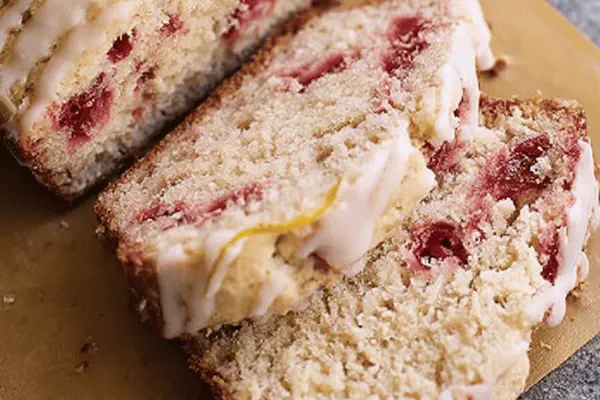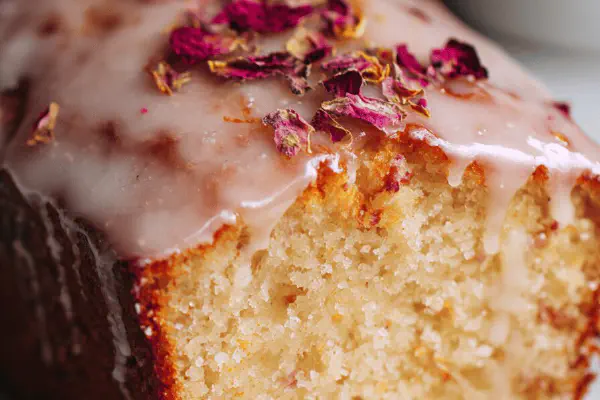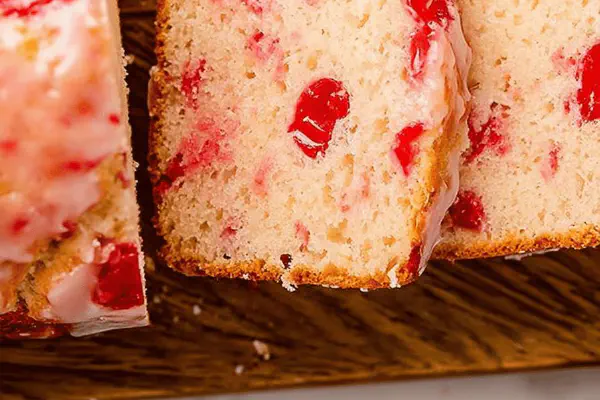Strawberry Lemon Yogurt Bread

E
By Emma
Certified Culinary Professional
•
Recipe tested & approved
A tangy, moist loaf with fresh strawberries and a bright lemon bite. Yogurt keeps it tender, applesauce replaces oil for moisture and a lighter crumb. Flour dusts the berries to avoid sinking. A simple glaze made of powdered sugar and lemon zest crowns the loaf with a sweet-tart finish. Baking cues rely more on scent and texture than times—listen for the soft crack as crust sets; toothpick test for internal doneness. Sub vanilla with almond extract for a nutty twist or swap strawberries for blueberries. Don’t overfold berries or color bleeds. Cooling on rack is essential to keep crust crisp beneath the glaze.
Prep:
30 min
Cook:
40 min
Total:
Servings:
8 slices
#quick breads
#strawberry recipes
#lemon desserts
#yogurt baking
#glazed breads
Strawberry lemon yogurt bread—a riff on classic quick breads, but with a few shifts I swear by. Yogurt swaps for oil or butter, adds tang and tender crumb without heaviness. Applesauce replaces some fat, cutting calories but keeping moisture. Lemons bring the brightness needed against sweet berries. I’ve learned the hard way on berries sinking to the bottom; tossing with flour works every time to suspend fruit throughout. The bake time fluctuates depending on your oven—watch for the aroma and crackling crust as your best guide. The glaze is the sweet kiss on top. Sometimes I swap vanilla for almond extract to deepen flavor. Leftovers? Toast and butter for breakfast magic.
Ingredients
- 1 1/2 cups all-purpose flour, plus 1 tbsp for coating berries
- 1 1/4 tsp baking powder
- 1/2 tsp salt
- 1 cup plain Greek yogurt (can substitute with sour cream or buttermilk)
- 3/4 cup granulated sugar
- 1/3 cup unsweetened applesauce (replace with vegetable oil for richer crumb)
- 2 large eggs
- Zest of 1 lemon
- 2 tbsp fresh lemon juice
- 1 tsp almond extract (replace vanilla for twist)
- 1 cup fresh strawberries, hulled and quartered
- For glaze: 3/4 cup powdered sugar
- 2–3 tsp milk
- 1 tsp lemon zest
About the ingredients
Flour quality matters—use all-purpose for best texture, no substitutions with bread or cake flour as it alters crumb drastically. Baking powder must be fresh; old leaveners cause dense bread. Greek yogurt is preferred for thickness, but sour cream or buttermilk works too, adding different tang tones. Applesauce is my fat replacement for moistness and slight sweetness, but oil can be used for richer texture. Fresh strawberries brighten the loaf, frozen can work if defrosted and patted dry but expect more color bleeding. Almond extract adds a deeper nuttiness in place of vanilla. Glaze base is simple—powdered sugar and milk—adjust fluid for drizzle or thicker coating. Patience cooling before glazing is key to avoid runny glaze soaking in.
Method
preheat and prepare
- Oven set to 350°F. Use nonstick spray or line a 9x5-inch loaf pan with parchment paper. Grease helps crust release cleanly without sticking. Don't skip.
dry mix
- Whisk 1 1/2 cups flour with baking powder and salt in a medium bowl. Aerate the flour mixture thoroughly to prevent dense loaf. Keep dry ingredients aside.
wet mix
- In separate bowl, combine Greek yogurt, sugar, applesauce, eggs, lemon zest, lemon juice, and almond extract. The yogurt adds moisture and acidity which reacts with baking powder for lift. Mix just until smooth—no overbeating. Batter will be slightly thick.
combine
- Add dry ingredients gradually into wet mixture, folding gently until just combined. Overmixing equals tough bread. Lumps okay here.
coat and fold berries
- Toss strawberries with 1 tbsp flour; this prevents sinking and color bleed. Fold berries into batter softly. Resist the urge to stir aggressively—tracks of berry juice in batter yield spots of flavor and color.
baking
- Pour batter into pan; tap gently on counter to release large air bubbles. Slide into oven. After ~40 minutes, oven aroma shifts from wet dough to sweet citrus smell. Top should be golden with firm edges and a soft crack sound when tapped. Toothpick comes out clean or with moist crumbs, not wet batter.
rest and cool
- Let loaf rest in pan for 10 minutes. Cooling starts crust formation. Loosen edges with a butter knife, invert onto a rack. Cool completely before glaze—warm glaze melts too much and soggy results.
glaze
- Whisk powdered sugar with 2 tsp milk and lemon zest. Adjust milk dropwise for desired flow. Too thick—add more milk gradually; too runny—powdered sugar boosts viscosity. Drizzle over cooled bread in thin streams. Let set at room temp for subtle sheen.
slice and serve
- Cut with a serrated knife to avoid crushing crumb. Store airtight to maintain moistness. Bread improves next day as flavors meld, but best within 2 days.
Cooking tips
Start with properly preheated oven; uneven heat leads to flat or gummy bread. Greasing loaf pan ensures easy release—don’t skip lining for sticky batter. Dry ingredients should be sifted or whisked separately to distribute leavening well. Mixing dry into wet in increments prevents lumps but mix only until no dry streaks remain. Overmixing builds gluten, yielding tough bread. Tossing berries in flour prevents sinking and preserves color—a step many overlook but critical. Pour batter carefully; tapping pan deflates big unwanted air pockets. Baking time varies: when crust turns golden with a slight crack, aroma deepens, and toothpick tests clean, it’s done. Resting in pan sets bread, removing early risks crumbling. Glazing only once fully cooled; too warm causes melt and soggy bread. Drizzle glaze thinly to keep balance. Serrated knife is your friend when slicing—press gently to retain loaf shape.
Chef's notes
- 💡 Flour dust on berries stops sinking — toss well but gently. Coating means berries stay suspended. I missed this once, ended up with reddish bottom layer.
- 💡 Mix dry ingredients separately — whisk to aerate. Helps lighten crumb. Dry powder clumps flatten bread texture if ignored entirely.
- 💡 Add dry into wet gradually — fold carefully. No overmixing or batter turns tough. Lumps are fine here, better than rubbery loaf.
- 💡 Oven cues beat timers. Smell changes from wet dough to citrus sweet smell around 35 min. Tap top for slight crack sound — means crust firming.
- 💡 Glaze only on fully cooled loaf. Hot bread melts glaze, makes it runny and soggy under crust. Adjust milk slowly; more for runny, less for thick drizzle.
Common questions
Can I swap strawberries for blueberries?
Yes, defrost frozen first. Pat dry or expect color bleed. Flour-coating also helps with blueberries same way as strawberries.
What if bread is dense?
Usually from overmixing or old baking powder. Aerate flours, don't rush folding. Fresh leavener critical. Or add little more yogurt for moisture.
How long to store loaf?
Wrapped airtight at room temp for couple days. Fridge keeps longer but dries crumb. Toasting next day revives texture. Freeze sliced for later.
Can I use vanilla extract instead of almond?
Definitely. Almond adds nuttiness, vanilla is more mellow. Swap 1:1. Changing extracts shifts flavor, no baking impact.



